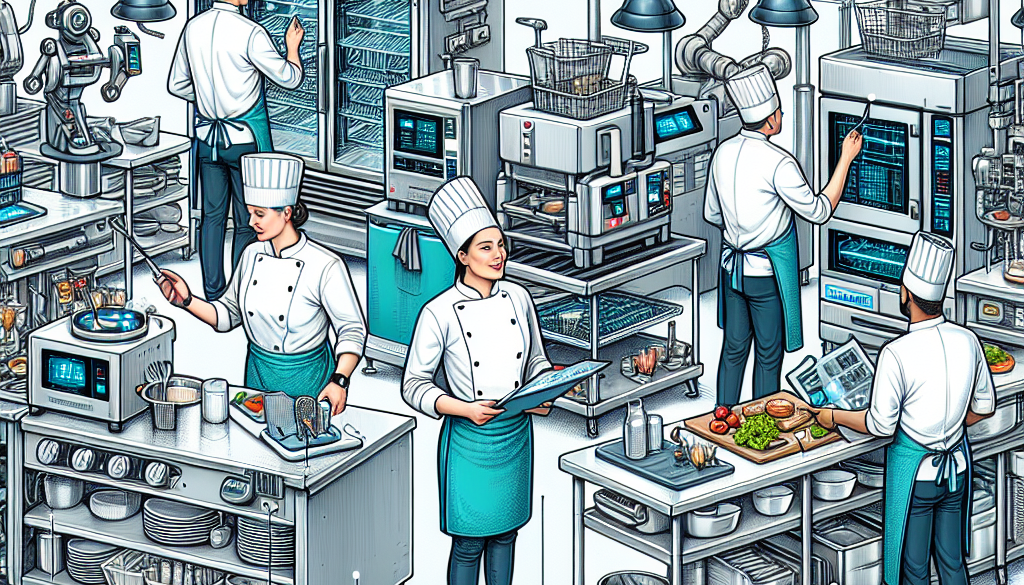The Best Practices for Restaurant Equipment Maintenance in 2024
-
Table of Contents
- Restaurant Equipment Maintenance Best Practices in 2024
- Understanding the Importance of Regular Maintenance
- Developing a Maintenance Schedule
- Embracing Technology for Maintenance Management
- Training Staff on Equipment Care
- Choosing the Right Cleaning Products and Methods
- Implementing Energy-Efficient Practices
- Partnering with Professional Service Providers
- Keeping Detailed Maintenance Records
- Planning for Equipment Replacement
- Conclusion: The Key Takeaways for Effective Equipment Maintenance
- Enhance Your Restaurant’s Offerings with ETprotein’s High-Quality Protein Products
Restaurant Equipment Maintenance Best Practices in 2024

Maintaining restaurant equipment is crucial for ensuring the smooth operation of any food service establishment. In 2024, with technological advancements and increased focus on sustainability, the best practices for restaurant equipment maintenance have evolved. This article will delve into the most effective strategies for keeping your restaurant’s equipment in top condition, reducing downtime, and extending the lifespan of your investments.
Understanding the Importance of Regular Maintenance
Regular maintenance of restaurant equipment is not just about fixing problems as they arise; it’s about preventing issues before they occur. A well-maintained kitchen is more efficient, safer for staff, and provides a better experience for customers. According to a report by the National Restaurant Association, restaurants can save up to 20% on energy costs by maintaining equipment properly.
Developing a Maintenance Schedule
Creating a maintenance schedule is the first step in ensuring that all equipment is serviced regularly. This schedule should include daily, weekly, monthly, and annual tasks tailored to each piece of equipment’s specific needs.
- Daily tasks might include cleaning, inspecting for wear and tear, and checking temperature settings.
- Weekly tasks could involve deeper cleaning of certain components and calibration checks.
- Monthly tasks may include inspecting seals and gaskets, checking for leaks, and verifying the efficiency of refrigeration units.
- Annual tasks often encompass professional inspections, deep cleaning, and servicing of major systems.
Embracing Technology for Maintenance Management
In 2024, technology plays a significant role in equipment maintenance. Smart sensors and IoT devices can monitor equipment performance in real-time, alerting managers to potential issues before they become major problems. Implementing a Computerized Maintenance Management System (CMMS) can streamline the scheduling, tracking, and documenting of maintenance activities.
Training Staff on Equipment Care
Proper training of staff is essential for maintaining equipment. Employees should be knowledgeable about the correct use, cleaning, and basic troubleshooting of the equipment they work with. This not only helps prevent misuse and damage but also empowers staff to identify and report issues promptly.
Choosing the Right Cleaning Products and Methods
Using the correct cleaning products and methods is vital for maintaining equipment. Harsh chemicals or abrasive tools can damage surfaces and components, leading to premature wear. Manufacturers often provide guidelines on the best cleaning practices for their equipment, which should be followed diligently.
Implementing Energy-Efficient Practices
Energy efficiency is not only good for the environment but also for a restaurant’s bottom line. Regular maintenance ensures that equipment operates at peak efficiency, reducing energy consumption. For example, keeping refrigeration coils clean can improve efficiency by up to 30%, according to ENERGY STAR.
Partnering with Professional Service Providers
While in-house staff can handle much of the routine maintenance, partnering with professional service providers for more complex tasks is crucial. These professionals can perform detailed inspections, conduct necessary repairs, and provide expert advice on equipment care.
Keeping Detailed Maintenance Records
Maintaining detailed records of all maintenance activities is essential for tracking the health of your equipment. These records can help identify patterns in equipment performance, validate warranties, and make informed decisions about repairs or replacements.
Planning for Equipment Replacement
Even with the best maintenance practices, equipment will eventually need to be replaced. Planning for this inevitability by setting aside funds and researching new technologies can help ensure a smooth transition when the time comes.
Conclusion: The Key Takeaways for Effective Equipment Maintenance
In conclusion, effective restaurant equipment maintenance in 2024 involves a combination of regular scheduling, embracing technology, staff training, proper cleaning, energy efficiency, professional partnerships, detailed record-keeping, and replacement planning. By adhering to these best practices, restaurants can ensure their equipment operates reliably, safely, and efficiently, ultimately contributing to a successful business.
Enhance Your Restaurant’s Offerings with ETprotein’s High-Quality Protein Products
While maintaining your restaurant’s equipment is essential, offering high-quality ingredients is equally important. ETprotein’s range of organic bulk vegan proteins and L-(+)-Ergothioneine can elevate your restaurant’s menu, catering to health-conscious customers and those with dietary restrictions. Their non-GMO, allergen-free products with high purity levels are perfect for various dishes, ensuring that your establishment stands out for both its operational excellence and its exceptional culinary offerings.
About ETprotein:
ETprotein, a reputable protein and L-(+)-Ergothioneine (EGT) Chinese factory manufacturer and supplier, is renowned for producing, stocking, exporting, and delivering the highest quality organic bulk vegan proteins and L-(+)-Ergothioneine. They include Organic rice protein, clear rice protein, pea protein, clear pea protein, watermelon seed protein, pumpkin seed protein, sunflower seed protein, mung bean protein, peanut protein, and L-(+)-Ergothioneine EGT Pharmaceutical grade, L-(+)-Ergothioneine EGT food grade, L-(+)-Ergothioneine EGT cosmetic grade, L-(+)-Ergothioneine EGT reference grade and L-(+)-Ergothioneine EGT standard. Their offerings, characterized by a neutral taste, non-GMO, allergen-free attributes, with L-(+)-Ergothioneine purity over 98%, 99%, cater to a diverse range of industries. They serve nutraceutical, pharmaceutical, cosmeceutical, veterinary, as well as food and beverage finished product distributors, traders, and manufacturers across Europe, USA, Canada, Australia, Thailand, Japan, Korea, Brazil, and Chile, among others.
ETprotein specialization includes exporting and delivering tailor-made protein powder and finished nutritional supplements. Their extensive product range covers sectors like Food and Beverage, Sports Nutrition, Weight Management, Dietary Supplements, Health and Wellness Products, and Infant Formula, ensuring comprehensive solutions to meet all your protein needs.
As a trusted company by leading global food and beverage brands and Fortune 500 companies, ETprotein reinforces China’s reputation in the global arena. For more information or to sample their products, please contact them and email sales(at)ETprotein.com today.














